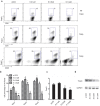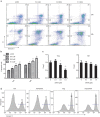SAHA, an HDAC inhibitor, synergizes with tacrolimus to prevent murine cardiac allograft rejection
- PMID: 22922441
- PMCID: PMC4002334
- DOI: 10.1038/cmi.2012.28
SAHA, an HDAC inhibitor, synergizes with tacrolimus to prevent murine cardiac allograft rejection
Abstract
Suberoylanilide hydroxamic acid (SAHA), as a histone deacetylase (HDAC) inhibitor (HDACi), was recently found to exhibit an immunosuppressive effect. However, whether SAHA can synergize with calcineurin inhibitors (CNIs) to inhibit allograft rejection and its underlying mechanism remain elusive. In this study, we demonstrated the synergistic effects of SAHA and non-therapeutic dose of tacrolimus (FK506) in prolonging the allograft survival in a murine cardiac transplant model. Concomitant intragraft examination revealed that allografts from SAHA-treated recipients showed significantly lower levels of IL-17 expression, and no discernable difference for IL-17 expressions was detected between SAHA- and SAHA/FK506-treated allograft as compared with allografts from FK506-treated animals. In contrast, administration of FK506 significantly suppressed interferon (IFN)-γ but increased IL-10 expression as compared with that of SAHA-treated animals, and this effect was independent of SAHA. Interestingly, SAHA synergizes with FK506 to promote Foxp3 and CTLA4 expression. In vitro, SAHA reduced the proportion of Th17 cells in isolated CD4⁺ T-cell population and decreased expressions of IL-17A, IL-17F, STAT3 and RORγt in these cells. Moreover, SAHA enhances suppressive function of regulatory T (Treg) cells by upregulating the expression of CTLA-4 without affecting T effector cell proliferation, and increased the proportion of Treg by selectively promoting apoptosis of T effector cells. Therefore, SAHA, a HDACi, may be a promising immunosuppressive agent with potential benefit in conjunction with CNI drugs.
Figures






Similar articles
-
SAHA, an HDAC inhibitor, attenuates antibody-mediated allograft rejection.Transplantation. 2013 Sep;96(6):529-37. doi: 10.1097/TP.0b013e31829b7bfc. Transplantation. 2013. PMID: 23912176
-
Synergistic effects of Isatis tinctoria L. and tacrolimus in the prevention of acute heart rejection in mice.Transpl Immunol. 2009 Dec;22(1-2):5-11. doi: 10.1016/j.trim.2009.09.004. Epub 2009 Sep 18. Transpl Immunol. 2009. PMID: 19766187
-
Effects of histone deacetylase inhibitor SAHA on effector and FOXP3+regulatory T cells in rhesus macaques.Transplant Proc. 2008 Mar;40(2):459-61. doi: 10.1016/j.transproceed.2008.01.039. Transplant Proc. 2008. PMID: 18374101 Free PMC article.
-
Inhibition of Histone Deacetylase 6 Reveals a Potent Immunosuppressant Effect in Models of Transplantation.Transplantation. 2016 Aug;100(8):1667-74. doi: 10.1097/TP.0000000000001208. Transplantation. 2016. PMID: 27222932
-
IL-2 therapy restores regulatory T-cell dysfunction induced by calcineurin inhibitors.Proc Natl Acad Sci U S A. 2017 Jul 3;114(27):7083-7088. doi: 10.1073/pnas.1620835114. Epub 2017 Jun 5. Proc Natl Acad Sci U S A. 2017. PMID: 28584086 Free PMC article.
Cited by
-
Prostate cancer cell-intrinsic interferon signaling regulates dormancy and metastatic outgrowth in bone.EMBO Rep. 2020 Jun 4;21(6):e50162. doi: 10.15252/embr.202050162. Epub 2020 Apr 21. EMBO Rep. 2020. PMID: 32314873 Free PMC article.
-
The Fate of Th17 Cells is Shaped by Epigenetic Modifications and Remodeled by the Tumor Microenvironment.Int J Mol Sci. 2020 Feb 29;21(5):1673. doi: 10.3390/ijms21051673. Int J Mol Sci. 2020. PMID: 32121394 Free PMC article. Review.
-
Epigenetic alterations are associated with monocyte immune dysfunctions in HIV-1 infection.Sci Rep. 2018 Apr 3;8(1):5505. doi: 10.1038/s41598-018-23841-1. Sci Rep. 2018. PMID: 29615725 Free PMC article.
-
Advances on Non-CD4 + Foxp3+ T Regulatory Cells: CD8+, Type 1, and Double Negative T Regulatory Cells in Organ Transplantation.Transplantation. 2015 Aug;99(8):1553-9. doi: 10.1097/TP.0000000000000813. Transplantation. 2015. PMID: 26193065 Free PMC article. Review.
-
Epigenetic regulation of tumor immunity.J Clin Invest. 2024 Jun 17;134(12):e178540. doi: 10.1172/JCI178540. J Clin Invest. 2024. PMID: 39133578 Free PMC article. Review.
References
-
- Nankivell BJ, Kuypers DR. Diagnosis and prevention of chronic kidney allograft loss. Lancet. 2011;378:1428–1437. - PubMed
-
- Hariharan S, Johnson CP, Bresnahan BA, Taranto SE, McIntosh MJ, Stablein D. Improved graft survival after renal transplantation in the United States, 1988 to 1996. N Engl J Med. 2000;342:605–612. - PubMed
-
- Pascual M, Theruvath T, Kawai T, Tolkoff-Rubin N, Cosimi AB. Strategies to improve long-term outcomes after renal transplantation. N Engl J Med. 2002;346:580–590. - PubMed
-
- Casey MJ, Meier-Kriesche HU. Calcineurin inhibitors in kidney transplantation: friend or foe. Curr Opin Nephrol Hypertens. 2011;20:610–615. - PubMed
-
- van de Wetering J, Koumoutsakos P, Peeters A, van der Mast BJ, de Kuiper P, Ijzermans JN, et al. Discontinuation of calcineurin inhibitors treatment allows the development of FOXP3+ regulatory T-cells in patients after kidney transplantation. Clin Transplant. 2011;25:40–46. - PubMed
Publication types
MeSH terms
Substances
LinkOut - more resources
Full Text Sources
Research Materials
Miscellaneous

